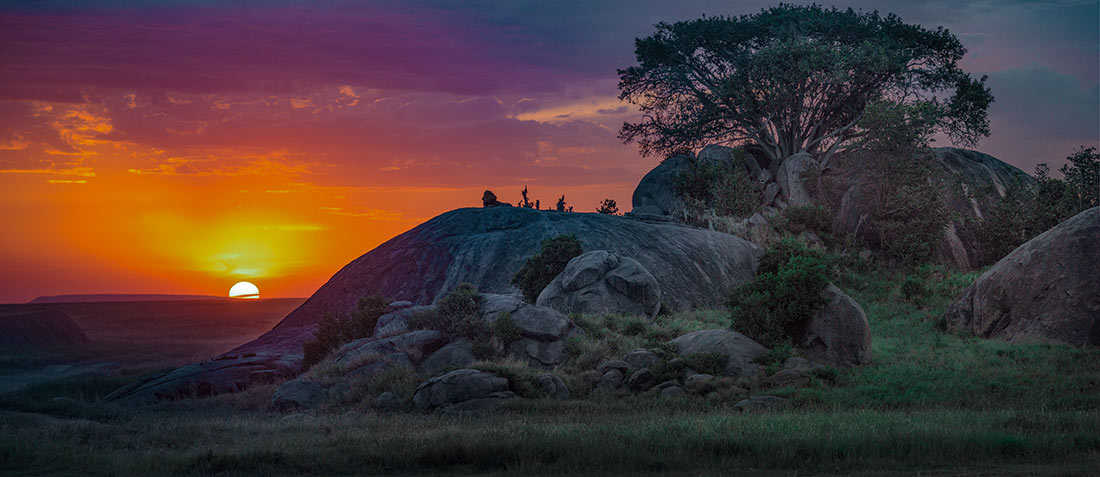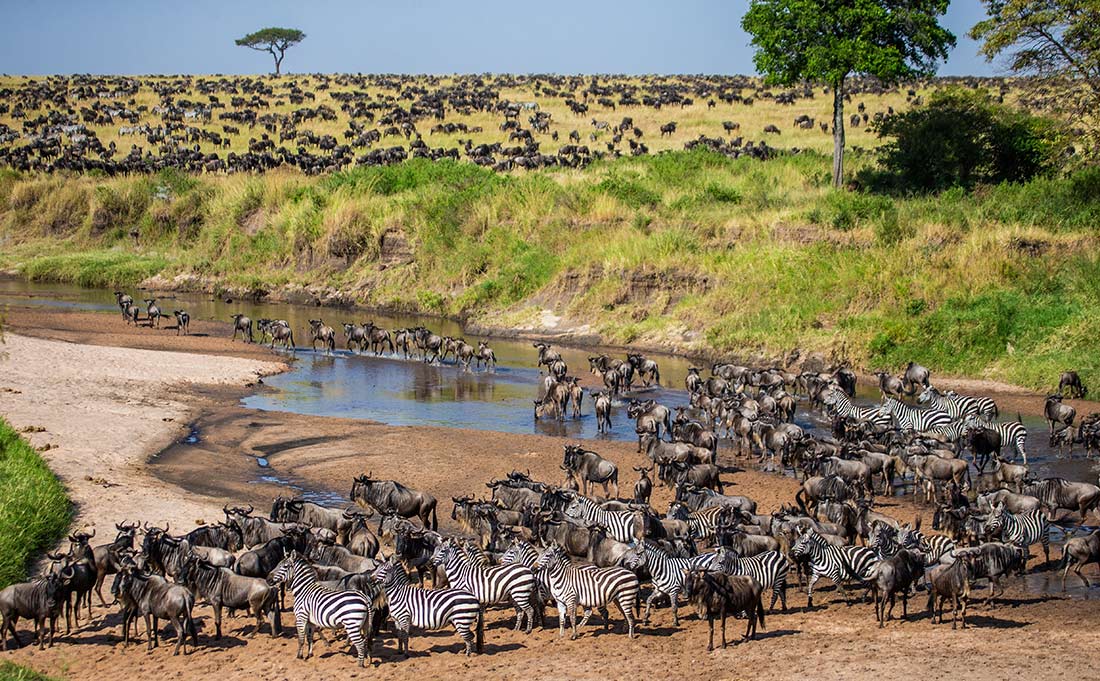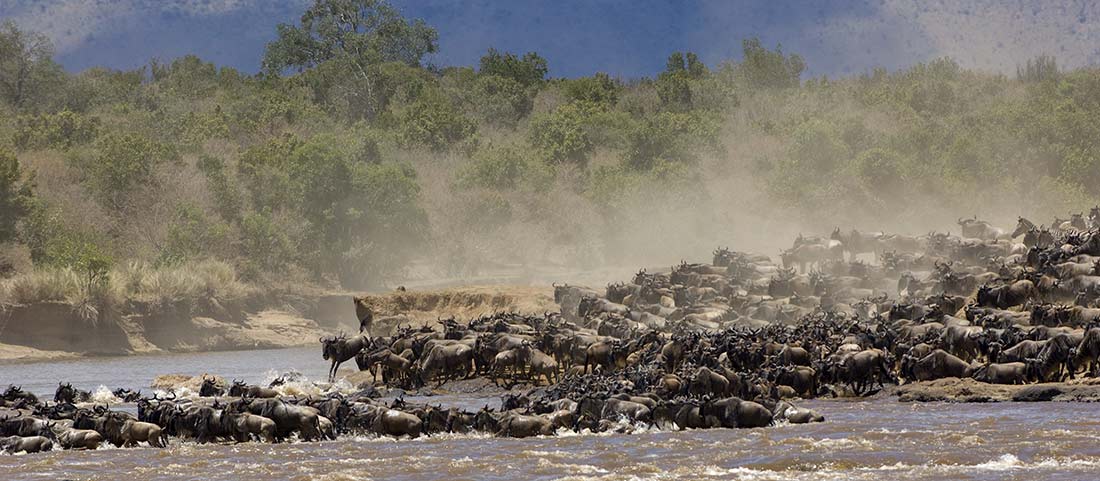Chances are that when you think of an African safari you think of Serengeti National Park. With its vast honey-hued plains of wildebeest, gazelles, and lions roaming freely. Well, you are not wrong. That is exactly what you’ll see when you visit the Serengeti.
The Serengeti is a magical place, home to one of the seven wonders of Africa, the Great Migration. With its never-ending large herd circling the park, it may very well be one of the last natural wonders on earth.
It is the only place where you can witness millions of migrating wildebeest over the Acacia plains. It is the cradle of human life, and probably the closest to an untouched African wilderness you will ever get.
History of Serengeti National Park
In the late 1800s and early 1900s, explorers and missionaries returned home with grand tales of the Serengeti plains and the massive numbers of animals found there.
Only minor details were known until explorers ventured there in the 1920s and early 1930s. They supplied the first references to the great wildebeest migrations and the first photographic evidence.
In 1930, an area of 2,286 square kilometers (1,420 miles) was established as a game reserve. It was in what is now southern and eastern Serengeti. They allowed sport hunting until 1937. After which they stopped all hunting activities. In 1940 the area was designated a Protected Area. In 1951 it was then upgraded to a National Park. At that time it covered the southern Serengeti and the Ngorongoro highlands. The park headquarters was on the rim of the Ngorongoro Crater.
Today the Ngorongoro Conservation Area (NCA) is separate from the Serengeti. That’s because, In 1959, they split the NCA from the National Park. Furthermore, they extended the boundary north to the Kenya border.
The main reason for separating the two parks was that the local tribe—the Maasai—realized eviction was looming. There could be no cattle grazing within the National Park boundaries. They protested. They reached a compromise. The Maasai were allowed to live and graze their cattle in the NCA but not within Serengeti National Park.
In 1961 Kenya established the Maasai Mara National Reserve.
In 1965 the Lamai Wedge between the Mara River and Kenya border was also added to Serengeti National Park. This created a permanent corridor for the wildebeests to migrate from the Serengeti plains in the south to the Loita plains in the north.
In 1962, they created the Maswa Game Reserve. In 1967 they added another small area north of the Grumeti River in the western corridor.
World Heritage Site
Serengeti National Park is also a UNESCO World Heritage Site. This means it is a landmark or area with legal protection by an international convention administered by the United Nations Educational, Scientific and Cultural Organization (UNESCO). They have cultural, historical, scientific, or other significance to humanity.
When the United Nations delegates met in Stockholm in 1981 the Serengeti was one of the first sites listed as a World Heritage Site. As early as the late 1950s it was recognized as a unique ecosystem. It provided us with many insights into how the natural world functions and shows us how dynamic ecosystems are.
About Serengeti National Park
The enchanting Serengeti is so amazing that it is hard to put into words the beauty, the wild, the rawness of it. It is something you have to experience to truly understand. A quote I once heard was, “If you can’t get excited here, then you just can’t get excited.”
It makes you feel like a kid watching all the wildlife—within arms reach of your safari vehicle—while you drive through the golden plains and marshy wetlands. There is a magical feeling of constantly being among thousands of animals. No matter what season you visit the Serengeti National Park, the migration is always active.
The Great Migration
It is true, that today, most visitors visit the Serengeti with one goal: to see the Lion King in real life. They want to witness millions of wildebeest, zebras, gazelles, and elands on a mass trek to find clean and safe water and to eat fresh grass. During this great cyclical movement, these ungulates move around the ecosystem in a seasonal pattern. Rainfall and healthy grass define the pattern. You cannot see this significant movement of animals anywhere else in the world.
The Herd Animals
The herd consists of wildebeest, buffalo, smaller groups of elephant and giraffe, zebra, Grants gazelles, and many antelope, such as eland, topi, kongoni, and impala.
The Big Five
The Serengeti is home to the Big Five. They are the Lion, African Buffalo, Elephant, Black Rhino, and Leopard.
Predators

Other animals
Other than the herd animals, there are many other creatures throughout the park. Hippotomus, Africa’s deadliest create wallows in its own filth in rivers and mud pits. Crocodiles and monitors frequently lurk nearby. Agama Lizard hangs out more in the rocky dry areas.
Many primates also live here like the pesky Baboons. Colobus, Blue, and Vervet monkeys also scurry freely in the parks and lodges.
It is also home to many birds: Flamingos, Ostrich, Kori Bustard, Goshawk, and African Pygmy Kingfisher are some of the most noteworthy.
A few other animals include the adorable dik-dik, the waterbuck, and the serval which is an ancestor to the modern-day house cat. And finally, don’t forget Pumba, he is a warthog and there are plenty of those.
Unlike other safari parks, another unique aspect of the Serengeti is there is no fence around it. This gives the animals enough space to make their return journey, one that they’ve been doing for millions of years. Read more about the Great Migration here: https://kilimanjarosunrise.com/the-great-migration/
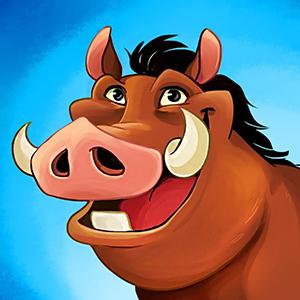
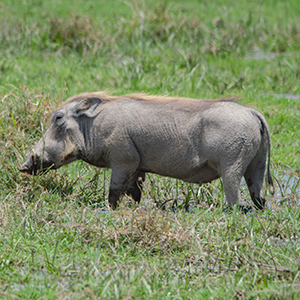
Tribes in Serengeti
Even though animals still rule the plains of the Serengeti, this area has an incredibly long history of human occupation. Not only humans but also human ancestors (Australopithecus Afarensis) lived in this area for almost 4 million years. Today, Serengeti National Park is still home to several indigenous tribes. As mentioned above, one of the most famous tribes is the Maasai. This tribe is unique and popular due to its long-preserved culture. Despite education, civilization, and western cultural influences, the Maasai people have clung to their traditional way of life. This makes them a symbol of Tanzanian and Kenyan culture. Read more about the Maasai people here: https://kilimanjarosunrise.com/tribes-of-tanzania/
Final Thoughts
Nature is unpredictable. One must have realistic expectations regarding witnessing the Grumeti river crossing or a large herd on the move. A river crossing lasts about 30 minutes making it easily missed. However, there will be plenty of animals to see despite that.
The Serengeti offers amazing wildlife viewing throughout the year. June and July are the best months for seeing the migration and a possible crossing of the Grumeti River.
The more famous river crossings of the Mara River occur around September in the north of the park. February is the best month for wildebeest calving. The dry months from June to October offer the best general wildlife viewing.
Whenever you choose to go, you’ll be amazed at the wildlife, landscape, and beauty that is the Serengeti.
